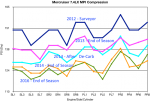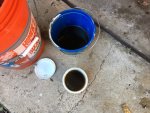Cooling System Flush Update:
Today was the day to do the iron flush of the cooling system. I drained the coolant and did a fresh water flush of the various parts of the engine. I pulled the fittings (plug and fitting) on the engine blocks, pulled the lower hose on the exhaust and the lower hose on the recirc pump, so that everything would drain.
Then I mixed about 20 oz. of Oxalic Acid powder with about 5 gallons of water. The directions said to do about 12 oz / 4 gallons of water, but I wanted to make the concentration a bit higher.
So, I filled the cooling systems (both engines) with the acid and topped them off with H2O. I ran the engines for about 15 mins and then again for about 5 mins. an hour later. My plan is to let the flush sit in the cooling system overnight and then run the engines some more tomorrow. Then I will drain, neutralize, flush and then load the cooling systems back up with AF.
An interesting Tidbit for everyone. . . The last time that I ran the engines, (about a week ago), I did a compression test and disconnected the coil wire at the distributors. Well for today, I had forgotten to re-attached the wire on the port engine. It was just lying on top of the distributor. Unknowingly, I went to start the port engine . . . it started up

. . . after the idle settled, it ran like craap and eventually stalled :grumpy:. I started it back up again and it still ran poorly and rough. So, I turned the engine off to take a look . . . The coil wire was just sitting there about 1/2" away from the center post on the distributor. :facepalm:
I was in total shock that the engine started and actually ran.

:faint2:

























